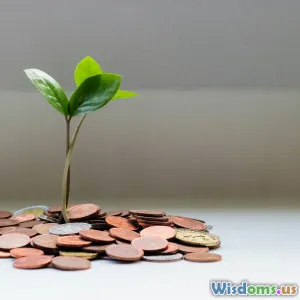
Five Surprising Ways Banks Are Embracing Sustainable Lending
10 min read Explore five innovative strategies banks use to promote sustainable lending and support environmental and social responsibility in finance. (0 Reviews)
Five Surprising Ways Banks Are Embracing Sustainable Lending
In an era where climate change and social responsibility dominate global conversations, banks are no longer passive players but active drivers of sustainable finance. Many people assume that banking and environmental sustainability don’t mix—after all, banks are fundamentally about finance, not ecology. However, the reality is much more nuanced and optimistic. Gone are the days when lending decisions focused solely on profitability; today, an increasing number of financial institutions incorporate sustainability into their core lending practices.
This comprehensive exploration unveils five surprising, innovative ways banks are embracing sustainable lending—approaches redefining how capital flows toward creating a more sustainable future.
1. Incorporation of Environmental, Social, and Governance (ESG) Criteria in Loan Approvals
One of the most impactful trends in sustainable lending is the integration of ESG criteria directly into loan decision processes. Traditionally, a bank’s credit evaluation centered around financial health metrics—such as credit score, revenue, and cash flow. However, leading banks now meticulously assess ESG factors of borrowers to determine lending risks and potential impact.
Why ESG Matters in Lending
Environmental policies influence risk exposure; for example, financing companies with poor environmental records could backfire through regulatory fines or reputational damage. Social factors (labor standards, community engagement) and governance practices (transparency, board diversity) also contribute to assessing borrower viability.
Real-World Example
Bank of America has developed an ESG risk evaluation framework that influences over $600 billion in lending annually. Their approach balances traditional credit considerations with ESG profiles, steering financing away from projects that might accelerate ecological degradation or social injustice.
Research published by the Harvard Business Review indicates companies with higher ESG scores tend to have a lower cost of capital, making them attractive prospects for banks specializing in sustainable finance. This integration signals a strategic, forward-thinking pivot in banking paradigms.
2. Launching Green and Sustainability-Linked Loans
Loans explicitly tied to sustainability outcomes represent another fascinating shift. Green loans earmark funds for environmentally beneficial projects, such as renewable energy installations, clean transportation, and energy-efficient building retrofits.
Differentiating Green Loans and Sustainability-Linked Loans
- Green Loans: Funds must be used exclusively for projects with positive environmental benefits.
- Sustainability-Linked Loans (SLLs): These offer flexible objectives by linking interest rates to performance against predefined sustainability targets, not restricting fund use strictly.
Innovative Practices and Data
HSBC reported over $30 billion in sustainability-linked loans in 2023 alone, targeting corporations actively reducing carbon footprints. In some agreements, interest rates decrease by 5-10 basis points if borrowers meet ambitious sustainability KPIs like cutting emissions or enhancing water efficiency.
Such dynamic instruments incentivize systemic change beyond mere compliance. This emerging market grew at a remarkable compound annual growth rate (CAGR) of 64% between 2017 and 2022 globally.
3. Supporting Circular Economy Initiatives through Targeted Financing
The linear 'take-make-waste' economic model is increasingly unsustainable, prompting banks to finance companies that adopt circular economy principles. This means supporting enterprises focused on resource efficiency, product life extension, recycling, and waste minimization.
Why It’s Surprising
Banking has historically favored traditional industries reliant on mass production and consumption. The pivot toward circular economy funding signifies a bold reconceptualization of lending priorities.
Case Study: ING’s Circular Lending Menu
ING Group offers bespoke loans promoting circular innovations such as recyclable packaging manufacturers or lease-based product companies. They combine market insight with tailored financial products, anticipating future shifts in consumer demand and regulatory landscapes.
These loans come with conditions to validate circular performance metrics, such as percentage of non-virgin materials used or waste reduction targets. By embedding such criteria, banks promote transparency and accountability.
4. Financing Social Enterprises and Impact-Driven Ventures
Sustainable lending extends beyond environmental concerns into social realms, where banks support enterprises solving pressing societal issues.
Extending Credit to Social Enterprises
Organizations such as microfinance institutions, affordable housing developers, and community health initiatives traditionally struggle with access to finance due to perceived higher risks and unconventional business models.
Banks like JPMorgan Chase have launched dedicated lending programs targeting social impact businesses—leveraging blended finance techniques to offset risk with philanthropy and government guarantees. In 2023, JPMorgan committed $150 billion toward advancing racial equity and community development through creative lending structures.
Real-World Impact
According to the Global Impact Investing Network, the impact investment market exceeded $1 trillion assets under management in 2022, with banks playing critical roles as financiers.
By blending financial returns with social benefits, banks diversify portfolio risk while contributing to inclusive development, promoting tangible progress toward United Nations Sustainable Development Goals (SDGs).
5. Utilizing Advanced Technologies to Advance Sustainable Lending Transparency
A less obvious but highly significant development is how banks leverage technology—like blockchain, AI, and big data analytics—to enhance the transparency, accountability, and efficiency of sustainable lending.
Blockchain and Sustainable Lending
Financial institutions are piloting blockchain solutions to trace the use of loan proceeds in real-time, ensuring green loans are not diverted to non-ESG activities. This distributed ledger technology reduces fraud risk and builds investor confidence.
For example, Rabobank’s blockchain-based platform tracks renewable energy project financing, giving stakeholders full visibility on fund deployment and associated environmental benefits.
Artificial Intelligence and ESG Assessment
AI-powered tools analyze vast ESG data sets, from satellite imagery to social media, providing a more accurate and granular evaluation of borrower impacts. Banks like Crédit Agricole use machine learning models to score corporate sustainability performance continuously, enabling dynamic risk mitigation.
Such tech tools expedite decision-making, reduce due diligence costs, and facilitate innovative lending products tailored to sustainability goals.
Conclusion: The Banking Sector’s Pivotal Role in Sustainable Financing
The transformation of how banks approach lending marks a crucial shift toward embedding sustainability across the financial ecosystem. From integrating ESG factors into credit assessments, tailoring green and sustainability-linked loans, financing circular economy businesses, supporting social impact ventures, to pioneering transparency-enhancing technologies—banks are on the frontline of fostering a resilient, equitable, and environmentally-conscious economy.
These five surprising strategies prove that sustainable lending is no longer a niche market but a mainstream imperative shaping the future of global finance.
For customers, investors, or policymakers aiming to catalyze real environmental and social progress, understanding these innovations clarifies how capital allocation aligns profit with purpose. As the pressure for responsible banking intensifies globally, institutions embracing sustainable lending set new standards that can inspire others to follow suit.
The future is green, equitable, and tech-driven—and banks embracing these trends will undoubtedly help fuel a sustainable world. Whether you are a business owner seeking financing or a consumer advocating for ethical finance, the revolution in sustainable lending presents vast opportunities waiting to be seized.
References:
- Bank of America ESG Annual Report 2023
- Harvard Business Review: Linking ESG to Cost of Capital (2022)
- HSBC Sustainability-Linked Loan Market Analysis 2023
- ING Circular Economy Lending Program Reports
- JPMorgan Chase Racial Equity Commitment 2023
- Global Impact Investing Network Annual Market Report 2022
- Rabobank Blockchain Pilot Initiatives
- Crédit Agricole AI Sustainability Scoring
Rate the Post
User Reviews
Popular Posts



















